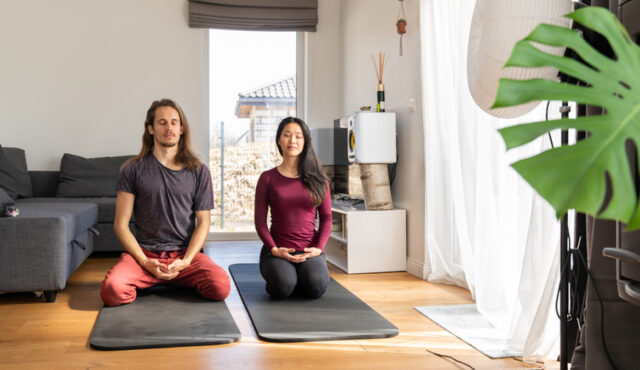“Practicing breathing exercises [with a partner] can put you in touch with the feelings of love and care that drew you together in the first place,” says mindfulness coach and mental health counselor Jen Johnson, LCMHC. “When you practice being still and focused on each other with kindness, you bring your awareness back to your connection.”
“Practicing breathing exercises [with a partner] can put you in touch with the feelings of love and care that drew you together in the first place.” —Jen Johnson, LCMHC, mindfulness coach and counselor
If you’ve struggled to maintain a mindfulness practice in the past, you also may find that sharing one with a partner helps to hold you both accountable, making you more likely to stick with the habit. Partnered breathing doesn’t have to be a massive time commitment, either. According to mindfulness experts, spending even just three to five minutes a day on shared breathwork can be beneficial.
Benefits of practicing partner breathing exercises
Doing a few minutes of slow, deep breathing per day on an individual basis has been shown to reduce stress and anxiety and enhance mood, largely through its ability to up-regulate the parasympathetic (aka “rest and digest”) nervous system, which enables the body to return to a relaxed state after a stressful event.
It only follows that engaging in such breathing exercises with a partner would allow you to share these calming benefits. As your measured inhales and exhales allow you to relax, your partner will be able to feel (and benefit from) your calm energy, and vice versa.
Focusing your attention on your breath can also put you into a more mindful state, which has long been associated with greater relationship satisfaction, through its effects on both the individual (being more mindful can help you better respond to stress and regulate emotions) and the couple (mindfulness may increase your ability to empathize). Other research has identified the positive influence of mindfulness on a person’s ability to accept their partner’s flaws and to perceive their partner as responsive as reasons why mindfulness can boost relationship satisfaction, as well.
According to trauma-informed breathwork coach and clinical hypnotherapist Rosanna Gill, partnered breathwork can also increase your and your partner’s awareness of your emotions and each other’s. This can help foster empathy, better communication, and a deeper understanding of each other’s perspectives. In fact, a small 2008 study of nine couples found that when the couples participated in just three breathwork sessions together, they reported a stronger emotional connection and understanding of each other, improved communication, and an increased sense of support.
Over time, engaging in partner breathing exercises can also enhance your and your partner’s ability to regulate your respective emotions, says clinical psychologist and mindfulness teacher Inna Khazan, PhD. “You can become more resilient together,” she adds, noting the importance of consistency for achieving that benefit. “A daily or regular practice will help train your nervous system to regulate itself better—and when you and your partner encounter stressful situations, your bodies and minds will be better prepared to respond to those situations in helpful ways,” she says.
4 breathing exercises to try with your partner
While almost any breathing exercise can be adapted to work for couples, the expert-recommended exercises below are particularly well-suited to practice with a partner.
Back-to-back 4-7-8 breathing
This exercise is based on 4-7-8 breathing, a technique popularized by integrative medicine specialist Andrew Weil, MD, that involves inhaling for a count of four, holding for seven, and exhaling for eight.
Gill recommends performing it back-to-back with a partner, as the physical contact can increase feelings of connection and make it easier to keep your breathing in sync.
How to try it:
- Sit facing away from your partner, with your backs touching, either cross-legged or knees bent with your feet flat on the floor.
- Choose which partner will lead the counting for the first five rounds. (You’ll switch roles for the second five rounds.)
- The leader then starts inhaling through the nose for four counts, holding for seven counts, and exhaling through the mouth for eight counts. The leader can count out loud, or their partner can simply listen closely to their breathing to follow their pace.
- Once both partners have done five rounds, sit silently, and take a few untimed inhales and exhales with each other. Notice how your breath and your partner’s breath sound. Notice how their back feels against yours.
- Repeat step three with the other partner leading this time.
Gratitude breathing
It’s easy to take your partner for granted, particularly if you’ve been together for a long time. This breathing exercise from Johnson offers an opportunity to focus on and express your appreciation for each other.
As a bonus, Johnson notes that it offers the potential for intense eye contact. Studies have shown that direct eye contact can create a feeling of “oneness” and deep connection with someone else, increase activity in the part of the brain responsible for processing emotions, and even build trust with the other person.
How to try it:
- Begin facing each other with your legs crossed. Gaze into your partner’s eyes.
- Bring your awareness to your breath, noticing the expansion of the chest and release of the belly with every inhale and exhale.
- Rest your left hand on your knee, and place your right hand over your partner’s heart.
- Bring your breath into rhythm with your partner’s, so that you’re inhaling and exhaling together.
- After inhaling and exhaling a few times in sync, start to focus on something about your partner for which you feel grateful. Notice the positive feelings and sensations that arise as you experience this gratitude.
- Breathe in sync for a few more cycles. Then, take a few moments to discuss your experience with your partner.
Heart rate variability breathing
According to a 2022 review of studies on breathwork, intentionally breathing at a slower pace (around six cycles per minute, versus the typical 12 to 20 cycles per minute) can increase heart rate variability (HRV), which is the differentiation in timing between two heartbeats. This metric tells you how quickly your heart speeds up when you put demands on it and how quickly it slows down in the wake of those demands; the greater your HRV, the more responsive your heart is to your environment, and the more regulated your nervous system. (In other words, you’re not constantly in fight-or-flight mode.)
Dr. Khazan’s go-to breathwork practice enlists such voluntary slow breathing to increase HRV over time, so that you’re better able to return to a state of calm after a stressful situation.
How to try it:
- Sit facing your partner.
- While taking your first breaths, focus on shifting your breathing from your chest into your belly.
- Begin inhaling in sync for a very slow count of four. Rather than trying to inhale as much air as possible, aim for a comfortable, normal-sized breath.
- Breathe out together through pursed lips, as if you were blowing out a candle, for a very slow count of six.
- Continue inhaling on a count of four and exhaling on a count of six this way for about three to five minutes. Over time, as you get more comfortable with the exercise, you can gradually build up to 10 or 20 minutes.
Pro tip: Try doing this exercise while holding hands with your partner. Research has shown that your brainwaves, heart rate, and breathing become synchronized with your partner’s when you hold hands.
Lovingkindness and compassion breathing
This exercise from Johnson is aimed at fostering compassion—which can benefit your relationship in numerous ways. Not only is it helpful for putting yourself in your partner’s shoes during times of conflict and reaching a place of understanding, but it also may make it easier to validate your partner’s emotions and experiences.
How to try it:
- Start seated, facing each other with your legs crossed.
- Look into each other’s eyes as you breathe normally, noticing the sensation of your chest and belly expanding with every inhale and falling with every exhale.
- Rest your left hand on your left knee, and place your right hand on your partner’s chest.
- Begin to focus on aligning your breath with your partner’s.
- Once you are breathing in sync, bring to mind a recent challenge or struggle your partner has faced. With each inhale, breathe in the emotions they may have felt while coping with this difficulty. With each exhale, radiate your empathy and heartfelt desire to relieve their pain.
- Begin silently repeating these words in your head: “May you be free from suffering. May you be happy and at peace.” Continue for two to three minutes.
Following this exercise, Johnson says you may notice a deeper sense of care, empathy, and understanding for your partner. If intense or overwhelming emotions arise during the practice, Johnson suggests journaling about them or considering discussing them with your partner.
Well+Good articles reference scientific, reliable, recent, robust studies to back up the information we share. You can trust us along your wellness journey.
- Magnon, Valentin et al. “Benefits from one session of deep and slow breathing on vagal tone and anxiety in young and older adults.” Scientific reports vol. 11,1 19267. 29 Sep. 2021, doi:10.1038/s41598-021-98736-9
- Balban, Melis Yilmaz et al. “Brief structured respiration practices enhance mood and reduce physiological arousal.” Cell reports. Medicine vol. 4,1 (2023): 100895. doi:10.1016/j.xcrm.2022.100895
- Russo, Marc A et al. “The physiological effects of slow breathing in the healthy human.” Breathe (Sheffield, England) vol. 13,4 (2017): 298-309. doi:10.1183/20734735.009817
- Kozlowski, Anna. “Mindful Mating: Exploring the Connection between Mindfulness and Relationship Satisfaction.” Sexual and Relationship Therapy, vol. 28, no. 1–2, Routledge (2013): 92–104, doi:10.1080/14681994.2012.748889
- Kappen, Gesa et al. “On the Association Between Mindfulness and Romantic Relationship Satisfaction: the Role of Partner Acceptance.” Mindfulness vol. 9,5 (2018): 1543-1556. doi:10.1007/s12671-018-0902-7
- Adair, Kathryn, et al. “The Effect of Mindfulness on Relationship Satisfaction via Perceived Responsiveness: Findings from a Dyadic Study of Heterosexual Romantic Partners.” Mindfulness, vol. 9,4 (2018): doi:10.1007/s12671-017-0801-3
- Chow, Wen Mei, et al. “Breathwork and Couple Relationships: A Qualitative Investigation.” Journal of Heart Centered Therapies, vol. 11, 2008, p. 91+, https://link.gale.com/apps/doc/A179075925/HRCA?u=anon~8858aa88&sid=googleScholar&xid=b0edd9fe.
- Zhou, Chu et al. “Direct Gaze Blurs Self-Other Boundaries.” The Journal of general psychology vol. 145,3 (2018): 280-295. doi:10.1080/00221309.2018.1469465
- Kawashima, R et al. “The human amygdala plays an important role in gaze monitoring. A PET study.” Brain : a journal of neurology vol. 122 ( Pt 4) (1999): 779-83. doi:10.1093/brain/122.4.779
- Kreysa, Helene et al. “Direct Speaker Gaze Promotes Trust in Truth-Ambiguous Statements.” PloS one vol. 11,9 e0162291. 19 Sep. 2016, doi:10.1371/journal.pone.0162291
- Laborde, S et al. “Effects of voluntary slow breathing on heart rate and heart rate variability: A systematic review and a meta-analysis.” Neuroscience and biobehavioral reviews vol. 138 (2022): 104711. doi:10.1016/j.neubiorev.2022.104711
- Goldstein, Pavel et al. “Brain-to-brain coupling during handholding is associated with pain reduction.” Proceedings of the National Academy of Sciences of the United States of America vol. 115,11 (2018): E2528-E2537. doi:10.1073/pnas.1703643115
- Goldstein, Pavel et al. “The role of touch in regulating inter-partner physiological coupling during empathy for pain.” Scientific reports vol. 7,1 3252. 12 Jun. 2017, doi:10.1038/s41598-017-03627-7











